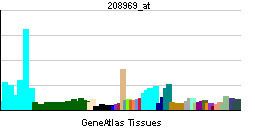Entrez 4704 | Ensembl ENSG00000139180 | |
 | ||
External IDs MGI: 1913358 HomoloGene: 3666 GeneCards: NDUFA9 | ||
NADH dehydrogenase [ubiquinone] 1 alpha subcomplex subunit 9 is an enzyme that in humans is encoded by the NDUFA9 gene. The NDUFA9 protein is a subunit of NADH:ubiquinone oxidoreductase (Complex I of the electron transport chain), which is located in the mitochondrial inner membrane and is the largest of the five complexes of the electron transport chain. Mutations in NADH dehydrogenase (ubiquinone), also known as Complex I, frequently lead to complex neurodegenerative diseases such as Leigh's syndrome. In the case of NDUFA9, a mutation to the MT-ND3 gene might interrupt their interaction and formation of subcomplexes, compromising Complex I function and leading to disease.
Contents
Structure
The NDUFA9 gene is located on the p arm of chromosome 12 in position 13.3 and spans 38,457 base pairs. The gene produces a 42.5 kDa protein composed of 377 amino acids. NDUFA9 is a subunit of the enzyme NADH dehydrogenase (ubiquinone), the largest of the respiratory complexes. The structure is L-shaped with a long, hydrophobic transmembrane domain and a hydrophilic domain for the peripheral arm that includes all the known redox centers and the NADH binding site. It has been noted that the N-terminal hydrophobic domain has the potential to be folded into an alpha helix spanning the inner mitochondrial membrane with a C-terminal hydrophilic domain interacting with globular subunits of Complex I. The highly conserved two-domain structure suggests that this feature is critical for the protein function and that the hydrophobic domain acts as an anchor for the NADH dehydrogenase (ubiquinone) complex at the inner mitochondrial membrane. NDUFA9 is one of about 31 hydrophobic subunits that form the transmembrane region of Complex I, but it is an accessory subunit that is believed not to be involved in catalysis. The predicted secondary structure is primarily alpha helix, but the carboxy-terminal half of the protein has high potential to adopt a coiled-coil form. The amino-terminal part contains a putative beta sheet rich in hydrophobic amino acids that may serve as mitochondrial import signal.
Function
The human NDUFA9 gene codes for a subunit of Complex I of the respiratory chain, which transfers electrons from NADH to ubiquinone. NADH binds to Complex I and transfers two electrons to the isoalloxazine ring of the flavin mononucleotide (FMN) prosthetic arm to form FMNH2. The electrons are transferred through a series of iron-sulfur (Fe-S) clusters in the prosthetic arm and finally to coenzyme Q10 (CoQ), which is reduced to ubiquinol (CoQH2). The flow of electrons changes the redox state of the protein, resulting in a conformational change and pK shift of the ionizable side chain, which pumps four hydrogen ions out of the mitochondrial matrix.
Clinical significance
Decreased expression of NDUFA9 is associated with Leigh's syndrome, a severe neurological disorder that typically arises in the first year of life, is characterized by progressive loss of mental and movement abilities, and typically results in death within a couple of years, usually due to respiratory failure. A mutation in the MT-ND3 gene (tyrosine to cytosine at the 10191 position) results in a substitution of serine for proline, which may introduce instability of Complex I due to the inability form subcomplexes between MT-ND3 and NDUFA9. However, this genetic identification may not be suitable for prenatal testing because of the mutation's age and tissue dependence.
